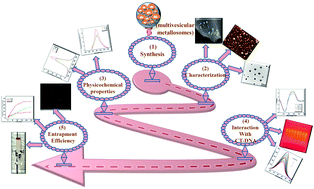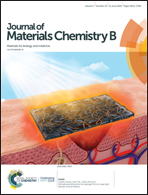Cholesterol-induced physicochemical changes in dodecylamine-based metallosomes: drug entrapping ability and interactions with biological molecules
Abstract
The present shifting its focus from natural lipid-based liposomes to liposomes synthesized from functionalized amphiphiles. The liposomes synthesized from functionalized amphiphiles are able to demonstrate their importance in the research field due to their additional functionalities and stability as compared to the liposomes synthesized from natural amphiphiles. Fascinated by their properties, herein, we synthesized liposomes from metal-functionalized surfactants known as metallosurfactants. The liposomes thus formed are commonly abbreviated as “metallosomes”. The present study was focused on the exploration of different aspects of these newly synthesized metallosomes from dodecylamine-based metallosurfactants. Different metallosomes were prepared with varying ratios of cholesterol (Chl). The polarity and fluidity of the metallosomal membrane were found to be altered with Chl variation, and this was estimated using the fluorescence probes 8-anilino-1-naphthalenesulfonic acid (ANS) and PRODAN. Different techniques, such as dynamic light scattering (DLS), X-ray diffraction (XRD), ζ-potential, differential scanning calorimetry (DSC), atomic force microscopy (AFM), field-emission scanning electron microscopy (FE-SEM) and transmission electron microscopy (TEM), were employed to characterize these synthesized metallosomes. The interaction of biomolecules with different reagents plays a significant role in life sciences, and metallosomes provide us the opportunity to study these interactions in the presence of structure-embedded metal ions. The ability of metallosomes to interact with calf thymus DNA (CT-DNA) was estimated using ζ-potential, circular dichroism (CD) and gel electrophoresis. Additional experiments were carried out with ethidium bromide (EtBr) to observe the capability of metallosomes to intercalate between CT-DNA base pairs. To accomplish the goal of employing metallosomes as a drug delivery vehicle, these synthesized metallosomes were further utilized as drug carriers for the antituberculosis drug rifampicin. The potential of these metallosomes as drug carriers was evaluated by their entrapment efficiency (EE) and in vitro release profiles. Confocal microscopy was employed to further investigate the entrapment efficiency of metallosomes.



 Please wait while we load your content...
Please wait while we load your content...